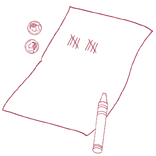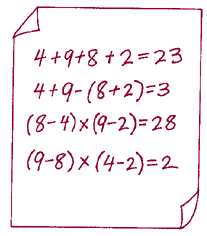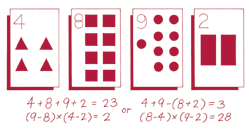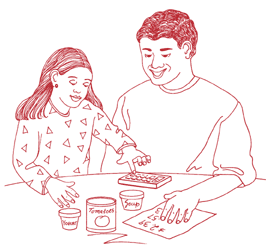|

Math for the Fun of It
More or Less (Grades K-2)
What you'll need:
One coin, number cards (from book cover), scratch paper, pen, and pencil
Two players will play a card game where each will draw a card. The players will compare cards to see who wins that round. Before you begin, flip the coin and call "heads" or "tails" to see if the winner of each round will be the person with a greater value card (heads) or a smaller value card (tails).
- To begin the game, divide the cards evenly between the two players.
- Place the cards face down. Each player turns over one card at a time and compares: Is mine more or less? How many more? How many less? The player with the greater or smaller value card (depending on whether heads or tails was tossed) takes both cards.
- The winner of the game is the player with more cards when all the cards are gone from the stack.
- Now try the same activity with each player pulling two cards and adding them. Which sum is more? How much more? How much less?
Parent Pointer - Playing with numeral cards helps children learn to compare quantities of numbers. Children can also learn addition and subtraction. |
 Problem Solvers
Problem Solvers (Grades 1-3)
What you'll need:
Enough sets of cards so that each player has a set of cards numbered 1 through 6.
- Super sums. Each player writes numbers 1-12 on a piece of paper. The object of the game is to be the first one to cross off all the numbers on this list. Use only the cards 1-6. Each player picks two cards and adds up the numbers on them. The players can choose to mark off the numbers on the list by using the total value or crossing off two or three numbers that make that value. For example, if a player picks a 5 and a 6, the player can choose to cross out 11, or 5 and 6, or 7 and 4, or 8 and 3, or 9 and 2, or 10 and 1, or 1, 2, and 8. If a player cannot cross off a number, the player loses the turn. The first player to cross off all the numbers wins.
- Make the sum of 100. Use only cards 1-6. Each player takes turns drawing a card and each player must take 6 cards from the deck. With each draw, a player decides whether to use the number on the card in the 10s place or the 1s place so that the numbers total as close to 100 as possible without going over. For example, suppose a player draws the following cards in this order: 1, 6, 3, 2, 3, 2, and chooses to use the numerals in the following way:
Parent Pointer - This card game helps children develop various ways to use numbers in different combinations and to see the many possibilities of arriving at the same sum by adding different sets of numbers. |
 Card Smarts
Card Smarts (Grades 3-5)
What you'll need:
Number cards, pencil, and paper
- How many numbers can we make? Give each player a piece of paper and a pencil. Using the cards from 1 to 9, deal four cards out with the numbers showing. Using all four cards and a choice of any combination of addition, subtraction, multiplication, and division, have each player see how many different numbers a person can get in 5 minutes. Players get one point for each answer. For example, suppose the cards drawn are 4, 8, 9, and 2. What numbers can be made?
- Make the most of it. This game is played with cards from 1 to 9. Each player alternates drawing one card at a time, trying to create the largest 5-digit number possible. As the cards are drawn, each player puts the cards down in their "place" (ten thousands, thousands, hundreds, tens, ones) with the numbers showing. Once placed, a card cannot be moved. The first player with the largest 5-digit number wins. For example, if a 2 was drawn first, the player might place it in the ones' place, but if the number had been an 8, it might have been put in the ten thousands' place.

Parent Pointer - This card game helps children develop strategies for using numbers in different combinations using addition, subtraction, multiplication, and division. |
 Play Store
Play Store (Grades K-5)
What you'll need:
Empty containers (cartons or boxes), old magazines, books, newspapers, calculator, pencil or crayon, and paper
- Help your child collect empty containers so that you can play as if you were shopping at the grocery store. Gather the items and put them on a table.
- Help your child think of a price for each item. Mark the prices on the containers. You can even mark some items on sale.
- Pretend to be the customer while your child is the cashier.
- Teach your child the difference between the math symbols (+, -, ÷, x, and =) and how they are used when using the calculator. Help your child add the prices of each item on the calculator and total the amount using the (=) symbol. Have your child write the total on a piece of paper, which will be your receipt.
- While you and your child play store, you can ask questions likehow much would it cost to buy three cartons of eggs? How much does 1 box of soap cost, if they are 2 for $5.00? How much is my bill, if I don't buy the cereal? How much more will it cost if I buy this magazine? Have your child estimate the amounts of the items you are buying. Check to see if the estimation is correct on the calculator.
Parent Pointer - Learning to use the calculator will help your child understand and apply estimation and reasoning skills, as well as learn addition, subtraction, division, and multiplication. |
Math Activities for Grades K-5:
|
|
|